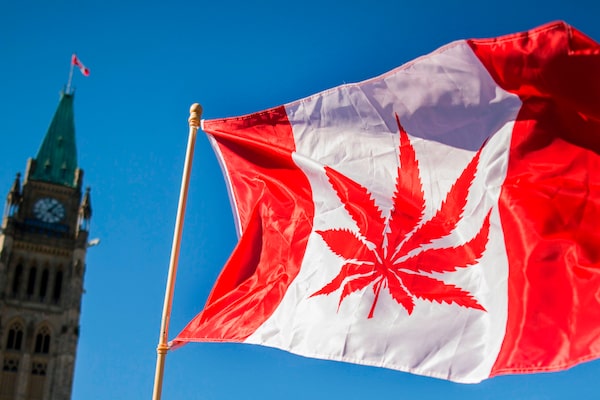
A flag with a marijuana leaf is held on Parliament Hill in Ottawa.CHRIS ROUSSAKIS/AFP/Getty Images
Beena Goldenberg is chief executive officer at Organigram.
Canada’s legal cannabis journey has been turbulent to say the least. What once seemed like a promising landscape of opportunity has evolved into a terrain fraught with unexpected hurdles, leading to a cascade of challenges for industry stakeholders.
To put things in context, in 2022, a staggering 41 per cent of Canadian companies seeking bankruptcy protection under the Companies’ Creditors Arrangement Act were from the cannabis sector, and 12 per cent of those filing the following year. These alarming statistics serves as a stark reminder of the industry’s struggle to meet the lofty expectations set during its nascent stages. Assumptions about market demand, pricing, regulatory frameworks and operational scalability have proved to be far more complex and unpredictable than initially envisioned.
The industry has looked toward the government for help. This isn’t just for its own sake – it’s about fairness for an industry that is disproportionately taxed, about protecting jobs and about ensuring a thriving industry can stamp out the illegal market.
The first milestone the industry was waiting for was the Legislative Review of the Cannabis Act. The review was prepared by a team of “experts” appointed by Health Canada and aimed to revisit how cannabis products are regulated. After consulting various groups, the panel made 54 recommendations and 11 observations on potential changes to the regulatory framework.
The panel made a positive recommendation, suggesting that “Finance Canada should consider a review of the excise tax model, recognizing that it was originally designed when the average price of dried cannabis was significantly higher than it is today.”
A recent survey by the Cannabis Council of Canada revealed that licensed cannabis producers remit as much as 35 per cent of their gross sales to excise duties. This heavy burden is a result of a formula developed by the federal government before the legalization of cannabis in 2018, when it was assumed that the average selling price for cannabis would be $10 per gram. Today, prices are closer to $3 per gram because of competition from illegal sellers. So, even though cannabis prices have dropped significantly, the excise burden has remained constant, or worsened.
In its prebudget submission to the Minister of Finance, the House of Commons Standing Committee on Finance recommended that the federal government: “Make adjustment to the excise duty formula for cannabis so that it is limited to a 10 per cent ad valorem rate, and to the operation of the duty, including the requirement to apply an excise stamp on cannabis products.”
But the budget released this week was disappointing. Many, including myself, had hoped the federal government would announce its intention to initiate a review of the cannabis excise framework. Unfortunately, no review was announced despite the collective pleas of the cannabis sector and other stakeholders.
While licensed producers, who are the backbone of this industry, struggle with profitability, the federal government collected $894.6-million in excise revenue from cannabis in 2022-23, surpassing the combined revenues from the sale of beer ($610.1-million) and wine ($277-million). This is notable given that Canada’s emerging regulated cannabis sector contends with robust competition from illicit suppliers, a challenge not shared by the beer and wine industries. And while the government recently introduced temporary excise relief measures for beer and wine, no such relief has been extended to the cannabis sector.
Largely because of this heavy excise burden, it has been reported that, in addition to the significant bankruptcies, a significant number of licensed cannabis producers have chosen not to remit excise payments to the Canada Revenue Agency. According to recent reports, at the end of 2023 federally licensed cannabis producers were in arrears of $273.4-million to the Canada Revenue Agency, which is a 72-per-cent increase from a year earlier. And only recently has the CRA moved to recoup these unpaid duties by garnishment through provincial government cannabis agencies.
Charting a course forward demands urgent excise reforms to ensure the survival and prosperity of the Canadian cannabis industry. The existing excise framework, a major impediment to industry progress, requires significant revision.
A proposed reduction to a 10-per-cent fixed rate of gross sales, together with changes to the physical product stamping requirements and the shifting of duty remittance away from the point of production to the point of sale are required for the sustainability of a young industry competing with an established illicit market.
These reforms will not only save jobs and increase government revenues but also empower companies to invest in the development of innovative products that attract more consumers to the legal market, and that’s what legalization is all about.